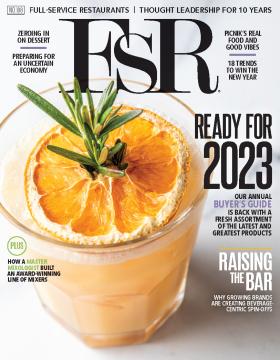The so-called '80/20' rule has caused much strife for operators, to the point that some are opting for full minimum wage as opposed to implementing a tip credit.
At the end of 2021, Victoria Vish, an associate with national law firm Ogletree Deakins, wrote a blog entitled, “Tale of the Partisan Pendulum,” speaking to how much differing political parties have shaped labor policies in the past decade.
Right now, the pendulum is swinging left, with Democratic President Joe Biden’s administration controlling matters. His leadership influenced the Department of Labor’s decision to resurrect the 80/20 rule, which went into effect in late December 2021. The mandate involves the tip credit, a standard that allows employers to pay tipped workers a lower minimum wage and let their gratuities cover the gap between the true minimum wage. For instance, a waiter being paid $2.13 per hour, but earning at least $5.12 in tips to reach $7.25 per hour. The $5.12 would be the tip credit.
The 80/20 rule states restaurants can only use the tip credit if a worker spends 80 percent of their time on tip-producing work and no more than 20 percent—or more than 30 continuous minutes—on tasks that “directly support” tip duties. Anything in excess of that 20 percent must be paid at the full minimum wage. If an employee spends more than 30 continuous minutes on directly supporting work, all of that time must be paid at full minimum wage. Any time spent on "unrelated work" must be paid at full minimum wage.
Here’s a better look at how these tasks are defined:
Tip-producing
Server
- Waiting tables
Busser
- Filling water glasses
- Clearing dishes from tables
- Replacing table linens
Bartender
- Making drinks
- Serving drinks
- Talking to customers
Directly supporting
Server
- Preparing items for tables to facilitate service
- Cleaning tables
- Folding napkins
- Preparing silverware
- Garnishing plates
- Sweeping under tables
Busser
- None identified
Bartender
- Preparing fruit garnishes
- Wiping down bar
- Wiping down tables in bar area
- Cleaning bar glasses and implements used behind bar
- Arranging bottles behind bar
- “Briefly” retrieving from storage items such as alcohol, ice, and napkins
Unrelated
Server
- Preparing food
- Cleaning bathroom
Busser
- None identified
Bartender
- Preparing food
- Cleaning dining room
This will likely be in place for the next two years, and potentially longer, if Biden or another Democratic candidate assumes office for another term. For businesses that found it difficult to keep up with these rules, they've decided to eliminate the tip credit entirely and go with full cash wages, Vish says. They're making up for those additional costs by adding automated charges onto customer bills and increasing menu prices.
"Customers are less inclined to give a tip on top of whatever that automatic charge is or higher menu prices," Vish says. "I think it's potentially hurting employees in that sense. So we're definitely seeing a shift away from using the tip credit as aggressively because of this rule. And it's not just the 80/20 component. It's that 30 minute rule that's just difficult to manage at the operational level."
There are seven states and territories that don't allow a tip credit: California, Oregon, Washington, Montana, Nevada, Minnesota, Nevada, Alaska, and Guam.
During the 2022 election cycle, removal of the tip credit was approved in Washington, D.C., but defeated in Portland, Maine. Under D.C.'s Initiative 82, the tip credit would be gradually eliminated over the course of five years. A similar measure was passed in 2018, but the D.C. Council voted 8-5 to repeal it. But now, the dynamics of the council have changed to where many believe the tip credit will go through, says Chuck McDonald, an Ogletree Deakins shareholder in Greenville, South Carolina.
The 80/20 rule is facing one major legal challenge. Late last year, the Texas Restaurant Association and The Restaurant Law Center, an entity under the National Restaurant Association, filed a lawsuit against the Department of Labor's new standard. Court documents say the ruling will "severely and irreparably harm thousands upon thousands of restaurants and their employees." It also argues that the Department of Labor doesn't have the power to enforce such a rule.
"The position was that this is a matter for Congress and legislation and it shouldn't be regulated by the D.O.L.," Vish says. "And that case is still pending. There's not been an opinion on that yet. But there's certainly challenges that are out there."
McDonald says the 80/20 rule creates a lot of opportunities for errors, even for restaurants that are trying to do it correctly. The attorney adds that restaurant employers should avoid having tipped workers come in before work or stay late afterward, unless they're willing to pay full minimum wage for those hours.
However, neither McDonald nor Vish have heard of any big employee lawsuits regarding violations of the rule.
"We're a year into it and the limitations period is longer than that," Vish says. "So whether people are waiting or there's confusion still and big ambiguity around the role, that could be possible too."
Another concern for restaurants entering 2023 is changing minimum wage laws. The Biden administration's attempted to pass a federal $15 per hour minimum wage in 2021, but efforts weren't successful. Since then, it's trended as more of a state issue, McDonald says. Twenty-three states will raise minimum wage when 2023 hits. Some have published bumps for the foreseeable future. For instance, in Delaware, there are scheduled rises in 2023, 2024, and 2025. This gradual rise gives employers more time to adjust budgets.
Sixty percent of states have minimum wages above the federal level of $7.25 per hour. McDonald says he isn't sure when the federal government will revisit a national standard, or if that would happen at all.
"The minimum wage is one that I would think both parties could get in line with," he says. "But there's two ways you look at it. One you say, almost 60-70 percent of the states have a higher minimum wage now than the federal, so why wouldn't you increase the federal? The flip side to that is, well, basically the states have taken ownership over the minimum wage, so we don't need to worry as much about it from a federal level. I'm just not sure which way that's going to go."
All of it points toward higher labor expenses for operators. The National Restaurant Association surveyed 4,200 restaurants between July 14 and August 5, and found that 86 percent were facing higher labor costs compared to 2019. These operators saw an 18.3 percent change, on average, increase from 2019 to 2022.




%20(1)_099fe.png)











